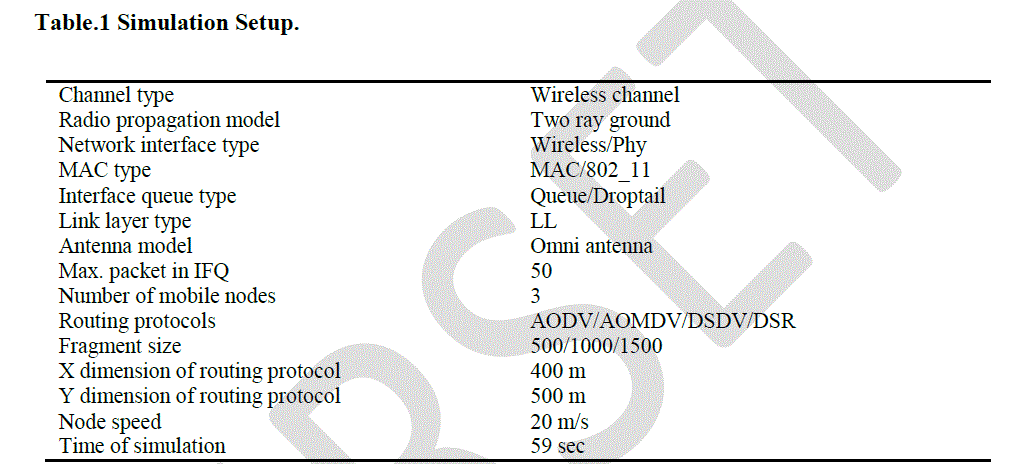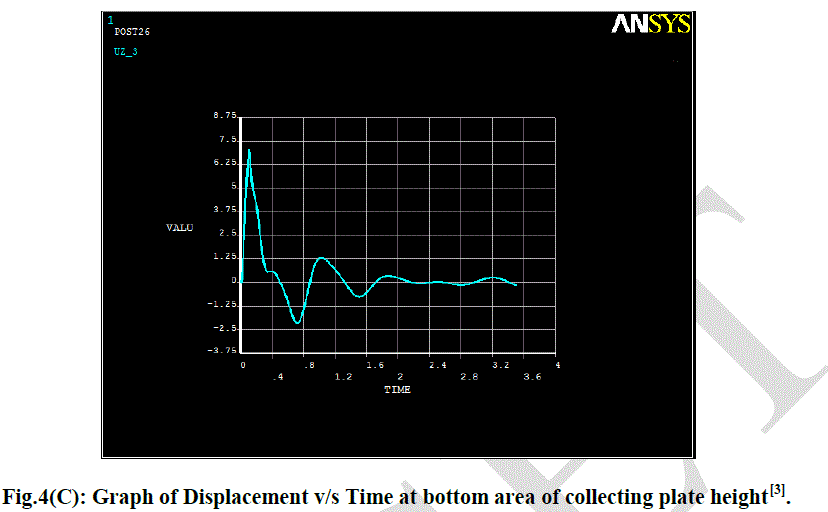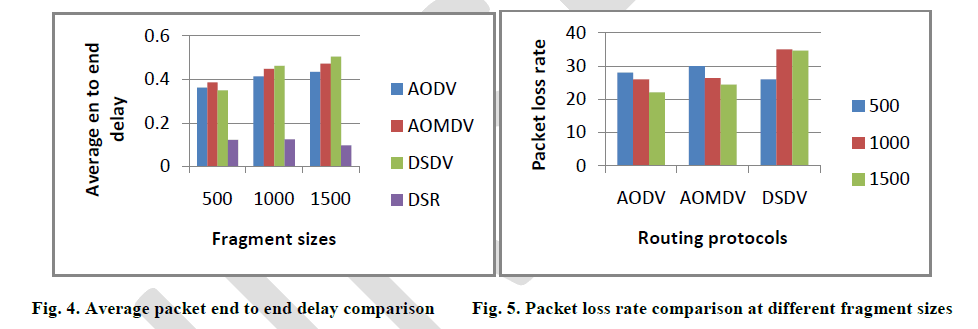ISSN ONLINE(2319-8753)PRINT(2347-6710)
ISSN ONLINE(2319-8753)PRINT(2347-6710)
Dr.Swati Sharma 1, Nandita Negi2 , Nipun Sharma3
|
| Related article at Pubmed, Scholar Google |
Visit for more related articles at International Journal of Innovative Research in Science, Engineering and Technology
With the significant increase in the demand of streaming videos over wireless networks leads to the huge challenge of providing high quality of services and standards to the users. So it is important to analyse the performance of streaming video transmission over mobile ad-hoc networks. In this paper, we scrutinize and evaluate the four routing protocols to check the performance of network parameters over varying fragment sizes. The fragment size plays the critical role in the traffic management of the network. The work is carried out using NS-2 and the routing protocols used are (AODV, AODMV, DSDV and DSR) for the different QoS metrics (average end to end packet delay and packet loss rate). Investigation leads to the results which help in tuning the network parameters for enhanced performance.
Keywords |
| AODMV, AODV, DSDV, DSR, H.264, QoS, Streaming videos, SVC. |
I. INTRODUCTION |
| The rigidness in H.264/AVC (advance video coding) standard leads to its extension H.264/SVC (scalable video coding) standard, which is better in the aspect of its flexibility [1]. On the other hand IEEE 802.11 WLAN (wireless local area network) especially MANET [2] (mobile ad-hoc network) provides the great application in the field of communication where it is impracticable or exorbitant to deploy the infrastructure. The transmission of video streaming over MANET had gained lot of attraction in the industry. Mobile ad-hoc network consist of independent mobile nodes which share communication between each other within the range of terrain. This paper concentrates on giving the general rule of thumb for better performance of the streaming videos over MANET. We used both types of routing i.e. “Table driven routing” as well as “On demand routing” [3]. These protocols are tested on different fragment sizes, which have the great influence over maintaining the traffic of data. Different network performance parameters used in this paper are average end to end delay and packet loss rate, which has the great impact on the performance of the network. The outcome of the result helps in optimizing the mobile ad-hoc network performance for transmission of streaming videos. The upcoming sections of the paper consist of following sections. The second section gives the basic concepts and briefing about the routing protocols used, H.264/SVC, SVEF framework. In the fourth section simulation scenario setup and results are discussed and finally fifth section concludes the paper. |
II. RELATED WORK |
| In “myEvalSVC: an Integrated Simulation Framework for Evaluation of H.264/SVC Transmission” by Chih-Heng Ke, integrated SVEF and NS2 to form a framework named nyEvalSVC for the evaluation of H.264/SVC transmission in a simulated environment.[14] In “SVEF: an Open-Source Experimental Evaluation Framework for H.264 Scalable Video Streaming” by Andrea Detti, Giuseppe Bianchi, Claudio Pisa, Francesco Saverio Proto, Pierpaolo Loreti, Wolfgang Kellerer, Srisakul Thakolsri, Joerg Widmer evaluated a framework which is fundamental instrument to fine tune the encoding parameters and the scheduling technique in a specific service environment. It provided a set of open-source tools and assess its effectiveness in evaluating the performance of a cross-layer scheduler in a WLAN hot-spot scenario.[15] And “Overview of the H.264/AVC Video Coding Standard” by Thomas Wiegand, Gary J. Sullivan, Gisle Bjøntegaard, and Ajay Luthra described an overview of H.264, technical features, applications and outcomes.[16] |
III. H.264/SVC |
| This section gives the brief idea about the streaming video compression standard, which is very well known as the extension of H.264/AVC video compression standard [1]. The main difference between these two standards is the presence of different layers in SVC. The bit stream comprises of a base layer and one or more than one enhancement layer. The base layer provides the basic video quality to the video and the enhancement layer gives smoothness to the quality of video [4]. One thing which is very important to notice is that without presence of base layer the enhancement layer is off no use. These types of features give flexibility in the streaming videos and help the network having unpredictable devices at the user end. The three types of scalability provided in SVC standard are: |
| ïÃâ÷ Spatial scalability |
| ïÃâ÷ Temporal scalability |
| ïÃâ÷ Signal to noise ratio (SNR) scalability |
| Spatial scalability and temporal scalability provides adaptation to the video resolution and frame rate respectively. The SNR leads to the adaption to the video quality. |
IV. SVEF EVALUATION FRAMEWORK |
| The Scalable Video coding streaming Evaluation Framework (SVEF) [5] is frame work for evaluating the performance of H.264/SVC format. It is the chain of software including JSVM [6] (joint scalable video model) packages. This is the open access software issued under GNU (general public licence). The whole process is consisting of encoding the raw YUV video into H.264/SVC format by stamping NALU header to the frames which contains the information of data it is carrying. This encoded video is transmitted over mobile ad-hoc network and analysed by using network simulator-2 (NS2) [7]. It is to be made clear that SVC videos are not directly simulated with NS2 although it is integrated to the framework with the help of either EvalSVC [8] or MyEvalSVC [9]. In this paper we have used MyEvalSVC toolset for simulations. The received video is then decoded back into YUV format and the results are evaluated through comparison. |
V. MANET ROUTING PROTOCOLS UNDER INVESTIGATION |
| Routing is defined as the way in which the packets from one node to other are transferred. The approach of routing packets in mobile Adhoc networks (MANETS) is pretty much different from wired scenario. As the topology of these network changes frequently so the nodes have to locate the existence of other nodes within the network. Similarly to declare their presence they broadcast and listen to the announcements from the neighbouring nodes. These nodes not only discover the presence of other nodes with in the terrain but also to transfer the data between each other. The MANET routing protocols are broadly classified into two categories [10]: |
| o Table driven routing - It is also known as proactive protocols in which each node in the network is maintained with time to time updated routing table. The route table is kept up to date by the exchange of control messages between the nodes presence in the scenario. Maintaining the routing table is the biggest challenge. |
| o On demand routing – These are the reactive protocols. As the name suggests “on demand” i.e. route is created when there is need of data to be delivered from sender to receiver i.e. from node to node. The temporary path is discovered between the sender and the receiver till the packets are completely delivered. In this there is not a requirement of any type of maintenance or to keep updates about the routes between the nodes. |
Ad-hoc on demand distance vector (AODV) |
| The AODV [11] [12] routing protocol is completely reactive protocol i.e. on demand routing protocol in which nodes communicate with each other only when one wants to transmit the data. The nature of communication between the nodes can be unicast or broadcast depending upon the requirement. It is advancement of DSDV in which the routing table has to be maintained throughout the connection. The route is made in AODV by transmitting the route request (RREQ) packet from the source to the destination through the intermediate nodes. This whole task is broadcast in nature and the nodes which had already received the request use to discard the packet. After the packet is delivered to destination then the shortest distance is decided and the routing route reply (RREP) is unicasted from destination to source. If there is any change in the node position or any node failure occurs between the paths then the route error (RERR) message is transmitted to the neighbouring nodes. The nodes which are not coming in the route do not participate in exchanging routing information. This technique of routing is very effective as the information is exchanged only on the requirement between the nodes. |
Destination sequenced distance vector (DSDV) |
| The DSDV is the table driven routing protocol. The route is maintained through the routing table. This routing table contains the information about all the nodes in the network i.e. nodes present in network, next node to each destination, metric and the sequence number. The route is decided through the sequence number [13] and metric used in the table. Only the table with most recently updated sequence number is used. This table is updated periodically or when the change in table has occurred. The updating of the routing table for regular interval of time makes the consumption of the battery power whether the network remains ideal or populated. |
Dynamic Source Routing (DSR) |
| Dynamic Source Routing (DSR) is a routing protocol for wireless mesh networks. It is similar to AODV in that it forms a route on-demand when a transmitting computer requests one. However, it uses source routing instead of relying on the routing table at each intermediate device. |
| Determining source routes requires accumulating the address of each device between the source and destination during route discovery. The accumulated path information is cached by nodes processing the route discovery packets. The learned paths are used to route packets. To accomplish source routing, the routed packets contain the address of each device the packet will traverse. This may result in high overhead for long paths or large addresses, like IPv6. To avoid using source routing, DSR optionally defines a flow id option that allows packets to be forwarded on a hop-by-hop basis. |
| This protocol is truly based on source routing whereby all the routing information is maintained (continually updated) at mobile nodes. It has only two major phases, which are Route Discovery and Route Maintenance. Route Reply would only be generated if the message has reached the intended destination node (route record which is initially contained in Route Request would be inserted into the Route Reply). |
| To return the Route Reply, the destination node must have a route to the source node. If the route is in the Destination Node's route cache, the route would be used. Otherwise, the node will reverse the route based on the route record in the Route Request message header (this requires that all links are symmetric). In the event of fatal transmission, the Route Maintenance Phase is initiated whereby the Route Error packets are generated at a node. The erroneous hop will be removed from the node's route cache; all routes containing the hop are truncated at that point. Again, the Route Discovery Phase is initiated to determine the most viable route. |
Ad-hoc On-demand Multi path Distance Vector (AOMDV) |
| Ad-hoc On-demand Multi path Distance Vector (AOMDV) Routing protocol is an extension to the AODV protocol for computing multiple loop-free and link disjoint paths. In AOMDV only disjoint nodes are considered in all the paths, thereby achieving path disjointness. For route discovery RouteRequest packets are propagated through out the network thereby establishing multiple paths at destination node and at the intermediate nodes The routing entries for each destination contain a list of the next-hops along with the corresponding hop counts. All the next hops have the same sequence number. This helps in keeping track of a route. For each destination, a node maintains the advertised hop count, which is defined as the maximum hop count for all the paths, which is used for sending route advertisements of the destination. Each duplicate route advertisement received by a node defines an alternate path to the destination. |
VI. SIMULATION SETUP AND RESULTS |
| The simulation scenario consist of streaming video transmission over IEEE 802.11 network consist of three independent mobile nodes i.e. node 0, node 1 and node 2. The node 0 transmits the H.264/SVC video to node 1 and node 2 with CBR and to node 2 with FTP respectively. |
 |
| The simulation is carried out using NS2 with parameters described in Table 1. Which is consist of terrain of 400 × 500 m having three mobile nodes moving in two ray ground propagation at speed of 20 m/s. The streaming video is transmitted between nodes with varying fragment sizes: |
| o 500 bytes |
| o 1000 bytes |
| o 1500 bytes |
| These fragment sizes with the above mentioned routing protocols are tested for different QoS metrics: |
| o Average end to end delay: Time taken by packets in a network to transmit from source to destination. |
| o Packet loss rate: Packets which fails to reach out the destination. The loss rate is calculated by dividing loss packet to total number of packets transmitted. |
Simulation Resultsc |
| The results are obtained by comparing packet end to end delay in Fig.1, Fig.2 and Fig. 3 for different fragment sizes 500 bytes, 1000 bytes and 1500 bytes respectively |
 |
| It is clearly visible that DSR perform have low packets end to end delay irrespective of the fragment sizes. The DSR protocol performs better at the lower fragment size of 500 bytes as compare to larger fragment sizes. AODV comes up with the second best option followed by AOMDV protocol. On the other hand DSDV have higher packet end to end delay. The enhanced performance of DSR is due to its self-organised network structure as it is on demand routing protocol. It is completely decentralised network without any central administration. The overhead bytes in DSR are less as compare to AODV because it does not uses routing messages periodically. |
 |
 |
| From Table 2 and Fig.4 it is clear that DSR protocol have lowest average end to end delay irrespective of fragmentation variation. Whereas rest all three protocols have higher average end to end delay but at lower fragment sizes especially at 500 bytes the results are better as compare to higher fragment sizes. |
| The results for packet loss rate are demonstrated in Table 3 and Fig.5, Where the comparison of packet loss rate is done at varying fragment sizes. In this AODV shows superior performance as compare to other protocols. One thing which is important to consider is that both the reactive protocols perform better at higher fragment sizes as compare to the proactive DSDV protocol which perform well at lower fragment size. |
VII. CONCLUSION |
| In this paper, an effort is made to have the comparison of reactive and proactive protocols (AODV, AOMDV, DSDV and DSR). We have done the simulation by transmitting the H.264/SVC format video over mobile Adhoc network and the QoS metrics like average end to end delay and packet loss rate is measured at varying fragment sizes. Our study outcome reveals that proactive routing protocol like DSDV perform inferior to reactive protocols like DSR. This is because reactive protocols look for fresh routing rather than not look for routing table like proactive routing protocols. |
References |
|